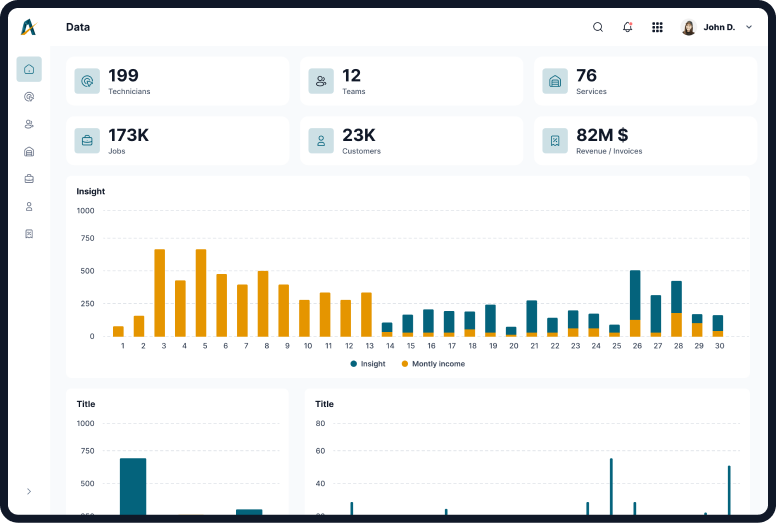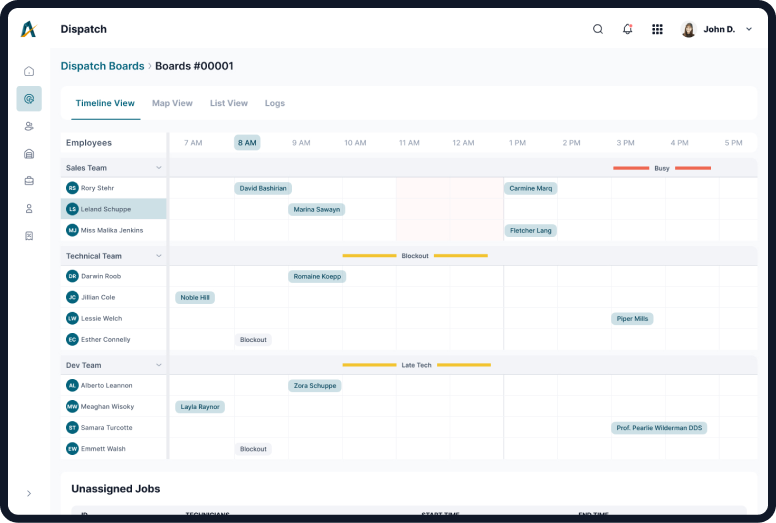
The Home & Commercial Services Industry, known as the “Trades,” is a $600 Billion, essential industry enabling Americans to live and work in their homes and offices with serenity. We’ve worked hard for the last couple of years to bring an innovative, intelligent software platform to enable hard-working men and women in the Trades to achieve more with fewer resources.
While working on Buck.ai and testing it out in different business environments, we realized that there were fundamentally wrong with the business operations in the trades and that there were many problems -some of them not discovered entirely- that Buck.ai would help with using technology.
Lack of conventions, overburden of waste, operational inefficiency, and emotional decision-making not relying on data collectively create organizational habits of not prioritizing profitability. However, this is, by design, the reason for the existence of service companies.
We’ve built Buck.ai to solve that.
At Buck.ai, we have a team with decades of experience in the trades and mastery over cutting-edge technologies such as AI, machine learning, and optimization. This enables us to build great software and put our products ahead of the competition.
However, technological advancements erode over time, and no matter how good we are at timing, it doesn’t sustain movements over the long term.
So we need principles that reflect Buck.ai’s approach and culture, coherent with the Trades. These principles are the pillars we use for product design and development to help our customers achieve the organizational excellence that Buck.ai is built for.
In other words, they are what makes Buck.ai different and unique. So, without further due, here is the Buck.ai doctrine on how home service companies should be run.
- 1. Optimize for Efficiency.
- 2. Put convention over configuration.
- 3. Data triumphs all.
- 4. Eliminate waste at all business levels.
- 5. Automate all possible decisions.

Materials and labor. That’s all there is to a service call, whether it’s a leaking toilet or a forty-thousand-dollar new equipment installation. Include indirect costs such as gas, and you have cost-of-goods-sold. You add sales, general, and admin costs (i.e., marketing and overhead) to all, and you’ve done 80% of your financial accounting.
We all know that. Then how come the EBITDA of any average service company doesn’t exceed 8% when the majority of the industry has calibrated itself to 50% gross profit? How can there be thousands of zero-dollar invoices annually, denoting technicians returning to jobs and wasting time and money because of forgotten parts or tasks?
In a perfect world, all your technicians are equally skilled and equally trained to convert the leads and upsell your customers. Your dispatchers know precisely which technician can outperform the others on a job-by-job basis. All route options yield the same mileage. You always have the same rate of capacity booked up throughout the year. And, of course, your marketing dollars are getting the same returns, regardless of the fluctuations your customer demand goes through.
However, it’s not a perfect world, thus a need to optimize for efficiency.
Your business creates value from the second your customers start interacting with your marketing channels until they hit submit for their Google review after completing a job. This is your value stream. Value flows from activity to activity, and unbeknownst to you; you’re losing money in this. Every decision on this stream should aim for better customer service, higher revenue, and fewer resources.
Think about your call center. The number of CSRs you need to hire is directly proportional to the average number of minutes they spend with the customer on the phone. Suppose you have a better triaging system (fewer resources) and a faster availability search for the best technician (higher revenue). In that case, you’ll end up booking jobs in half the time you’re used to doing (fewer resources and better customer service).
Apply that notion to every activity along the value stream, and you’ll waste fewer resources and become much more profitable than today.
This is what Buck.ai is built for.
After seeing hundreds of service companies, it always surprises me how much effort service company executives exert to configure their company operating systems, i.e., CRMs.
Typically, given the same trades and similar team sizes, and similar geographies to serve, a company in Lafayette, AR, doesn’t differ too much from a company in Jacksonville, FL. They can use the same approach for their job types, business units, tags, rules, and even zones.
Then why every single company needs to reinvent the wheel when categorizing and executing their work? Why do we need drastically different classifications for calls, jobs, teams, etc., that are changing from business to business?
Here’s why: Eight years ago, the field services industry was blessed with new software platforms enabling you to run your business from inside a browser. These tools, albeit potent, deliberately avoided embedding standard operating procedures into their features, leaving the choice of how narrow or wide you want your classifications to be to owners or managers.
This was an odd choice in an industry where many coaching, best practice, advisory, and heroic programs exist. Think about it: nothing is preventing a plumbing company from using another one’s classes, such as job types or business units. But the impact was more significant: Every classification effort divides your data into slices, and once the slice is too small or too big, it loses the ability to be represented in a meaningful manner. Make your cut too big, and you end up reading your reports being too generalist or make it too small, and you end up with data meaning nothing to you.
The same thing happens at every single point of the value stream. There’s the right amount of fine-tuning required for any categorization effort inherent to your business, and most companies miss that.
Our approach is different. If you don’t know how to set up your teams, job types, tags, or call probing questions, we have a solution built right into Buck.ai. You don’t need to think about it. It’s a culmination of analyzing millions and millions of jobs to find the right tune for the instrument we call the service business today. All you have to do is to activate these best practices, or conventions, with a switch.
Once you activate a trade on Buck.ai, you can move forward with our standards or implement your own. Using the standards can reduce your onboarding time to under 24 hours. Also, using our standards allow you to compare yourself with other companies, apples to apples.
This also extends to major KPIs measured on Buck for measuring business performance. What’s your membership conversion rate? How is your capacity usage for the next N weeks? Which one of your technicians is on a downhill slide, meaning they’ll underperform if something is not done on time? How effective are your dispatchers, even without Buck.ai?
Those questions and their answers are built into Buck.ai, allowing you to work with peace of mind, fully aware that you’re using industry-standard conventions and do not need to configure anything.
You’re sitting on a mountain of business data. And it is not used correctly. Data tells the truth more than anything on employee performance, seasonality, growth, failing areas, etc., to let you understand where your business is coming from, where it is now, and where it is going.
You think you know what’s happening in your business. However, there’s an epidemic failure of using business data in the Trades. The truth is, most of the time, you have limited visibility obscured by presumptions, biases, emotions, and data visualized or presented poorly.
You need pages of report setup you need to do every time you ask for a simple KPI. You’re getting tables, not graphs or data visualizations, as results which makes the reports harder to understand and take action upon. Also, you’re presented with interfaces showing every report as if they’re of the same importance. In contrast, the truth is you need five to eight metrics monitored on a daily basis to see how your business is performing, day in and day out.
As another failure of poor data usage, there’s almost zero prediction built into your daily workflows. Prediction means actionable insights into the short-term future, relying on models smartly trained on clean-cut data. You have all you need in your mountain: seasonality, market trends, weather, etc. Why don’t you have scientific predictions that might bring added value to your business?
The truth is data can cut through all of this as a knife to show you what’s happening and what might happen. Buck.ai is built with the principle that the cold, hard facts emanating from data are above everything else and provide more guidance on the business itself.
Data triumphs all.
Toyota, among all other car manufacturers, dominated the US market for decades with its unrivaled production philosophy. Fortunately, they’ve shared their pioneering philosophy with the world, and we learned what made them successful.
They started with a concept called “Muda,” the Japanese term for waste. Yes, all the activities that were not bringing value to the end-user were tagged as waste and fought with action plans to eliminate or reduce them.
The result? The most profitable car company in the world for decades; and market leader in most hostile countries.
No offense, but we see the polar opposite of this in the Trades. Zero-dollar invoices, lost parts, overburden in inventory, poor planning, wasted mileage, etc. It doesn’t end there: marketing spending without an in-depth look at campaign efficiency, sloppy purchasing behavior, etc.
The result? Decreasing profits despite increasing fees and prices.
As the old saying goes, if you stare long enough at the abyss, the abyss will stare right back at you. Buck.ai is built with the notion of making waste transparent at every level of the organization and easy-to-use action plans to overcome that.
The most significant waste in a service business is time. Time spent servicing a client you served poorly a month ago, time spent driving instead of being with the customer, time spent making low-level decisions such as sequencing the maintenance calls or warranty visits.
And it’s not just about time. It’s also about biases or efficiency. This is why, as a 21st-century company relying and operating on data, you need to automate low-level decision-making as much as possible.
Who should be assigned to what? What would be the order of jobs for any technician to ensure minimum mileage and driving time? What should be the priority of a warranty call? What should be the optimum inventory for the upcoming seasonal trend? How can we ensure we don’t spend more time, money, and resources than necessary? What would be the pricing of a service based on seasonality, market trends, and weather?
Your “automated intelligence” should automatically answer those questions, not you.